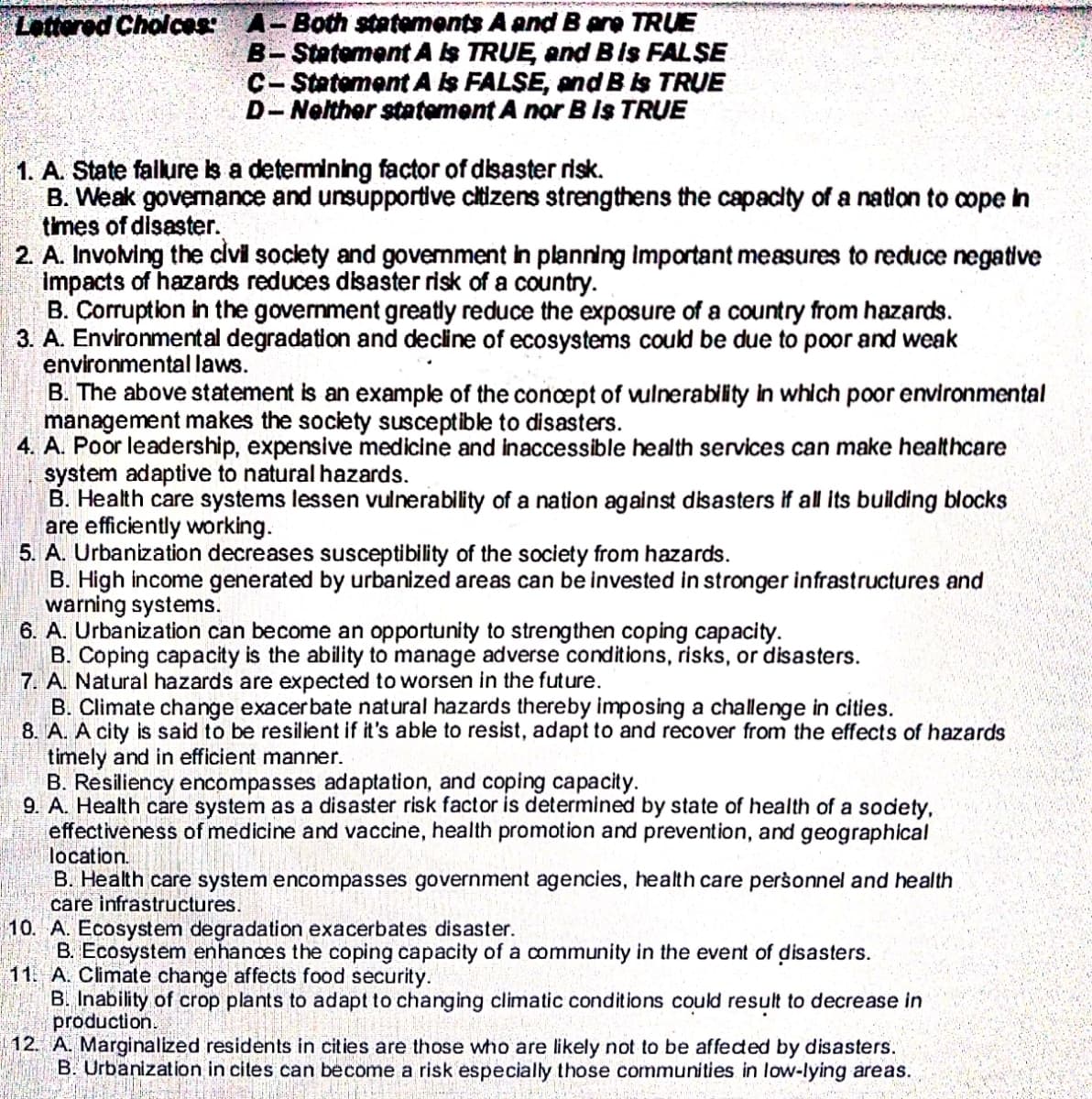Modified true or false for numbers, 11, 12 and 13
Social Psychology (10th Edition)
10th Edition
ISBN:9780134641287
Author:Elliot Aronson, Timothy D. Wilson, Robin M. Akert, Samuel R. Sommers
Publisher:Elliot Aronson, Timothy D. Wilson, Robin M. Akert, Samuel R. Sommers
Chapter1: Introducing Social Psychology
Section: Chapter Questions
Problem 1RQ1
Related questions
Question
Modified true or false for numbers, 11, 12 and 13

Transcribed Image Text:13. A Disaster risk is determined by exposure, vulnerability, and coping capacity.
B. There is an inverse relationship between disaster risk and vulnerability.
14. A. Hazard is the same disaster.
B. Disasters are due to hazards.
15. A. Cremating corpses of COVID19 casualties is necessary to prevent possible transmission of the
virus.
B. The act of cremating corpses of COVID 19 casualties increase disaster risk.

Transcribed Image Text:Lattered Cholces: A-Both statements A and B are TRUE
B-Statement A Is TRUE, end Bis FALŞE
C- Statement A Is FALSE, and B is TRUE
D-Nelther statement A nor B Is TRUE
1. A. State failure is a determining factor of disaster risk.
B. Weak governance and unsupportive citizens strengthens the capacity of a nation to cope in
times of disaster.
2. A. Invoving the civi society and govemment in planning Important measures to reduce negative
impacts of hazards reduces disaster risk of a country.
B. Corruption in the govemment greatly reduce the exposure of a country from hazards.
3. A. Environmental degradation and decline of ecosystems could be due to poor and weak
environmental laws.
B. The above statement is an example of the concept of vulnerability in which poor environmental
management makes the society susceptible to disasters.
4. A. Poor leadership, expensive medicine and inaccessible health services can make healthcare
system adaptive to natural hazards.
B. Health care systems lessen vulnerability of a nation against disasters if all its building blocks
are efficiently working.
5. A. Urbanization decreases susceptibility of the society from hazards.
B. High income generated by urbanized areas can be invested in stronger infrastructures and
warning systems.
6. A. Urbanization can become an opportunity to strengthen coping capacity.
B. Coping capacity is the ability to manage adverse conditions, risks, or disasters.
7. A. Natural hazards are expected to worsen in the future.
B. Climate change exacerbate natural hazards thereby imposing a challenge in cities.
8. A. A city is said to be resilient if it's able to resist, adapt to and recover from the effects of hazards
timely and in efficient manner.
B. Resiliency encompasses adaptation, and coping capacity.
9. A. Health care system as a disaster risk factor is determined by state of health of a sodiety,
effectiveness of medicine and vaccine, health promotion and prevention, and geographical
location.
B. Health care system encompasses government agencies, health care personnel and health
care infrastructures.
10. A. Ecosystem degradation exacerbates disaster.
B. Ecosystem enhances the coping capacity of a community in the event of disasters.
11. A. Climate change affects food security.
B. Inability of crop plants to adapt to changing climatic conditions could result to decrease in
production.
|12. A. Marginalized residents in cities are those who are likely not to be affeded by disasters.
B. Urbanization in cites can become a risk especially those communities in low-lying areas.
Expert Solution
This question has been solved!
Explore an expertly crafted, step-by-step solution for a thorough understanding of key concepts.
Step by step
Solved in 2 steps

Recommended textbooks for you

Social Psychology (10th Edition)
Sociology
ISBN:
9780134641287
Author:
Elliot Aronson, Timothy D. Wilson, Robin M. Akert, Samuel R. Sommers
Publisher:
Pearson College Div

Introduction to Sociology (Eleventh Edition)
Sociology
ISBN:
9780393639407
Author:
Deborah Carr, Anthony Giddens, Mitchell Duneier, Richard P. Appelbaum
Publisher:
W. W. Norton & Company

The Basics of Social Research (MindTap Course Lis…
Sociology
ISBN:
9781305503076
Author:
Earl R. Babbie
Publisher:
Cengage Learning

Social Psychology (10th Edition)
Sociology
ISBN:
9780134641287
Author:
Elliot Aronson, Timothy D. Wilson, Robin M. Akert, Samuel R. Sommers
Publisher:
Pearson College Div

Introduction to Sociology (Eleventh Edition)
Sociology
ISBN:
9780393639407
Author:
Deborah Carr, Anthony Giddens, Mitchell Duneier, Richard P. Appelbaum
Publisher:
W. W. Norton & Company

The Basics of Social Research (MindTap Course Lis…
Sociology
ISBN:
9781305503076
Author:
Earl R. Babbie
Publisher:
Cengage Learning

Criminalistics: An Introduction to Forensic Scien…
Sociology
ISBN:
9780134477596
Author:
Saferstein, Richard
Publisher:
PEARSON

Sociology: A Down-to-Earth Approach (13th Edition)
Sociology
ISBN:
9780134205571
Author:
James M. Henslin
Publisher:
PEARSON

Society: The Basics (14th Edition)
Sociology
ISBN:
9780134206325
Author:
John J. Macionis
Publisher:
PEARSON